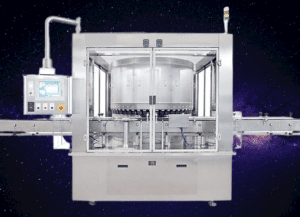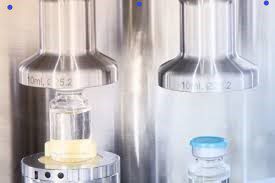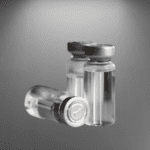vacuum leak test apparatus used to ensure the integrity of your product packaging this advanced equipment is designed to detect even the tiniest leaks. Improve quality control and meet regulatory standards effortlessly with our state-of-the-art vacuum leak test apparatus. Stay ahead in the pharmaceutical industry and safeguard the efficacy and safety of your products with this innovative solution.

Working principle of vacuum leak test apparatus
The vacuum leak test apparatus used in the pharmaceutical industry operates on a simple yet effective working principle. The apparatus creates a controlled vacuum environment within a test chamber or enclosure containing the pharmaceutical packaging to be tested. Here’s how it typically works:
- Preparation: The pharmaceutical product or package is placed inside the test chamber, ensuring it is properly sealed and connected to the apparatus.
- Vacuum Creation: The apparatus initiates a vacuum by removing air or gas from the test chamber, creating a pressure differential between the inside and outside of the packaging.
- Stabilization: Once the desired vacuum level is reached, the system stabilizes to ensure a consistent test condition.
- Observation: The apparatus monitors the vacuum level within the test chamber, looking for any significant changes or deviations.
- Leak Detection: If there is a leak in the packaging, air or gas will slowly enter the test chamber, causing a rise in the vacuum level. The apparatus detects this change and indicates the presence of a leak.
- Analysis and Results: The apparatus provides real-time data and measurements related to the leak, such as the leak rate or leak location. This information helps in assessing the integrity of the packaging.

Technical Details of the Vacuum Leak Test Apparatus
| Aspect | Description |
|---|---|
| Test Chamber | A sealed enclosure where the pharmaceutical packaging is placed for testing. |
| Vacuum Generation | Creates a controlled vacuum within the test chamber using a vacuum pump. |
| Vacuum Measurement | Monitors and displays the vacuum level within the test chamber in units such as millibar or Pascal. |
| Leak Detection | Detects changes in vacuum levels that indicate the presence of a leak in the packaging. |
| Leak Rate Measurement | Quantifies the rate at which the vacuum level changes, providing information about the severity of the leak. |
| Data Analysis | Provides real-time data and measurements for analysis, including leak rate, time, and other relevant parameters. |
| Alarm/Indication | Generates alerts or notifications when a significant leak is detected, ensuring prompt attention and action. |
| Process Control | Allows for setting and controlling test parameters such as vacuum level, stabilization time, etc. |
| Reporting | Generates comprehensive reports with test results, including pass/fail status and detailed information. |
| Calibration | Requires periodic calibration to ensure accuracy and reliability of the apparatus. |
| Compliance | Meets industry standards and regulatory requirements for leak testing in the pharmaceutical sector. |
Major Components of the Vacuum Leak Test Apparatus
The vacuum leak test apparatus used in the pharmaceutical industry typically consists of several main components that work together to facilitate the testing process. Here are the key components commonly found in such apparatus:
- Test Chamber: A sealed enclosure where the pharmaceutical packaging is placed for testing. It ensures a controlled environment for leak detection.
- Vacuum Pump: Generates and maintains the desired vacuum level within the test chamber by removing air or gas from the system.
- Vacuum Gauge: Measures and displays the vacuum level within the test chamber, allowing operators to monitor the pressure accurately.
- Leak Detection Mechanism: Utilizes various methods, such as pressure sensors or mass spectrometers, to detect changes in the vacuum level caused by leaks in the packaging.
- Control Panel: Provides a user interface to set and control test parameters, monitor the testing process, and view test results.
- Data Acquisition System: Collects and records data related to the vacuum level, leak detection, and other relevant parameters for further analysis.
- Alarm/Indication System: Generates alerts or notifications, such as audible alarms or visual indicators, when a significant leak is detected.
- Calibration Mechanism: Allows for periodic calibration of the apparatus to ensure accuracy and reliability in leak detection.
- Exhaust System: Facilitates the release of air or gas from the test chamber after the testing process is complete.
- Safety Features: Includes features such as emergency stop buttons, pressure relief valves, and safety interlocks to ensure operator safety during the testing process.

Validation Steps to qualify the vacuum leak test apparatus.
The validation process of a vacuum leak test apparatus in the pharmaceutical industry typically involves several steps to ensure its reliability, accuracy, and compliance with regulatory requirements. Here is an overview of the validation process:
- User Requirement Specification (URS): Define the specific requirements of the vacuum leak test apparatus based on the intended use, regulatory guidelines, and internal quality standards.
- Installation Qualification (IQ): Verify that the apparatus is correctly installed and meets all the necessary installation criteria. This includes checking electrical connections, proper placement, and adherence to safety protocols.
- Operational Qualification (OQ): Perform comprehensive testing to ensure that the apparatus operates according to the defined specifications. This includes verifying the functionality of various components, such as the vacuum pump, gauges, controls, and alarm systems.
- Performance Qualification (PQ): Validate the performance of the vacuum leak test apparatus under realistic operating conditions. This involves conducting leak tests using known calibrated leaks or simulated packaging defects to evaluate the apparatus’s sensitivity, accuracy, and repeatability.
- Calibration and Verification: Regularly calibrate the apparatus using traceable standards to maintain accuracy. Verify the accuracy and reliability of the apparatus by comparing its readings against known reference leaks or standards.
- Standard Operating Procedures (SOPs): Develop detailed SOPs for the operation, maintenance, and calibration of the vacuum leak test apparatus. Ensure that operators are trained on these procedures to ensure consistent and reliable results.
- Documentation and Record-Keeping: Maintain comprehensive documentation of all validation activities, including test protocols, results, calibration records, and any deviations or corrective actions taken. These records should be regularly reviewed and updated as part of quality management practices.
- Regulatory Compliance: Ensure that the validation process aligns with applicable regulatory requirements, such as Good Manufacturing Practices (GMP) or relevant guidelines from regulatory authorities such as FDA or EMA.
- Periodic Review: Conduct periodic reviews of the validation process to assess the ongoing performance of the vacuum leak test apparatus and identify any necessary adjustments or improvements.

Advantages & disadvantages of vacuum leak test apparatus
| Advantages | Disadvantages |
| 1. High Sensitivity: Can detect even minuscule leaks in packaging, ensuring product integrity. | 1. Initial Cost: Vacuum leak test apparatus can have a higher upfront cost compared to some other leak detection methods. |
| 2. Non-Destructive Testing: Does not damage the packaging during testing. | 2. Equipment Complexity: Vacuum leak test apparatus can be intricate and require skilled operators for proper functioning. |
| 3. Wide Range of Applications: Suitable for various types of pharmaceutical packaging, including bottles, blister packs, vials, etc. | 3. Test Time: Depending on the setup and test parameters, vacuum leak testing may require more time compared to other methods. |
| 4. Real-Time Data and Analysis: Provides real-time data on leak rates, allowing for immediate analysis and decision- making. | 4. Skill Requirements: Proper training and expertise are necessary to operate the apparatus effectively and interpret results. |
| 5. Compliance with Standards: Helps pharmaceutical companies comply with regulatory standards for leak testing. | 5. Limited Portability: Some vacuum leak test apparatus can be large and less portable, limiting their mobility in the production environment. |
| 6. Limited Applicability: Vacuum leak test apparatus may not be suitable for certain packaging materials or unique product configurations. |
Frequently Asked Technical Questions about Vacuum Leak Test Apparatus
How does a vacuum leak test apparatus work?
Answer: A vacuum leak test apparatus creates a controlled vacuum environment within a test chamber. The apparatus measures the vacuum level and detects any changes that indicate the presence of leaks in the packaging.
What is the sensitivity of the apparatus in detecting leaks?
Answer: The sensitivity of a vacuum leak test apparatus can vary depending on the model and specifications. However, it is designed to detect even minuscule leaks in pharmaceutical packaging, ensuring product integrity.
What is the range of vacuum levels that can be achieved by the apparatus?
Answer: The range of vacuum levels achievable by a vacuum leak test apparatus depends on its design and capabilities. Common ranges are typically expressed in millibars or Pascal units.
How is the vacuum level measured and displayed during the testing process?
Answer: The vacuum level is measured using a vacuum gauge or sensor integrated into the apparatus. The measured vacuum level is displayed on the control panel or digital display of the apparatus.
What are the different leak detection methods employed by the apparatus?
Answer: Vacuum leak test apparatus can utilize various leak detection methods, including pressure decay, mass spectrometry, helium leak detection, or bubble emission techniques, depending on the specific model.
Can the apparatus handle different types and sizes of pharmaceutical packaging?
Answer: Yes, vacuum leak test apparatus can be designed to accommodate various types and sizes of pharmaceutical packaging, including bottles, blister packs, vials, and more. The apparatus may offer interchangeable fixtures or adjustable settings to accommodate different packaging configurations.
What is the typical test time required for conducting a leak test?
Answer: The test time can vary depending on factors such as the size of the packaging, desired vacuum level, and the apparatus’s capabilities. Typically, test times can range from a few seconds to several minutes.
How accurate and reliable are the leak detection results provided by the apparatus?
Answer: Vacuum leak test apparatus can provide accurate and reliable leak detection results, but the accuracy may vary depending on the specific apparatus and its calibration. Regular calibration and proper usage are essential for ensuring accurate results.
Is the apparatus capable of detecting leaks in both liquid and gas-filled packaging?
Answer: Yes, vacuum leak test apparatus can be designed to detect leaks in both liquid and gas-filled pharmaceutical packaging. The testing methodology may differ based on the specific type of packaging.
What are the calibration requirements for the vacuum leak test apparatus?
Answer: Calibration requirements may vary depending on the manufacturer’s recommendations and industry standards. It is generally recommended to calibrate the apparatus periodically to maintain its accuracy. Calibration may involve adjusting pressure sensors, verifying vacuum levels, or comparing readings against known reference standards.
You may also read about Indian pharmacopeias
